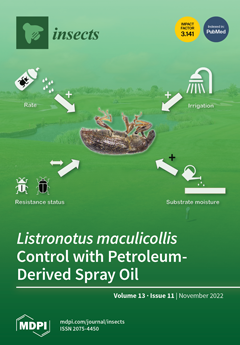Arbovirus diseases, such as dengue, chikungunya, and Zika, are important public health problems. Controlling the major vector,
Aedes aegypti, is the only approach to suppressing these diseases. The surveillance of this mosquito species needs effective collecting methods. In this study, a simple
[...] Read more.
Arbovirus diseases, such as dengue, chikungunya, and Zika, are important public health problems. Controlling the major vector,
Aedes aegypti, is the only approach to suppressing these diseases. The surveillance of this mosquito species needs effective collecting methods. In this study, a simple MosHouse sticky trap was evaluated in a semi-field condition. Our results demonstrated the efficiency of this trap in collecting
Ae. aegypti males, and no significant difference (
p > 0.05) in the numbers of males was detected when compared with the widely used BG- Sentinel trap. However, there were significantly lower numbers of females (
p < 0.05) collected using the MosHouse trap when compared to the BG-Sentinel trap. We also found a significant difference (
p < 0.05) in the collected numbers between irradiated and non-irradiated males. More irradiated males were collected in the MosHouse traps. The improvement of male collection was achieved with the addition of a sugar stick and sticky flags. Significantly higher numbers of males were collected in the MosHouse trap with sticky flags compared to the original one when they were released independently of females, but both were collected in higher numbers when they were released together (
p < 0.05). In conclusion, our experiments demonstrated that the MosHouse trap could sample
Ae. aegypti, especially males, as efficiently as the established BG-Sentinel trap, while the cost was more than 50 times lower, showing the potential of the MosHouse trap for improved
Ae. aegypti male and female surveillance with very large numbers of traps at affordable costs. In addition, significantly (
p < 0.001) increased male sampling was achieved by adding an external sticky flag on the MosHouse trap, providing an avenue for further development of the novel male-trapping strategy.
Full article






